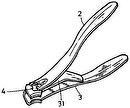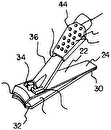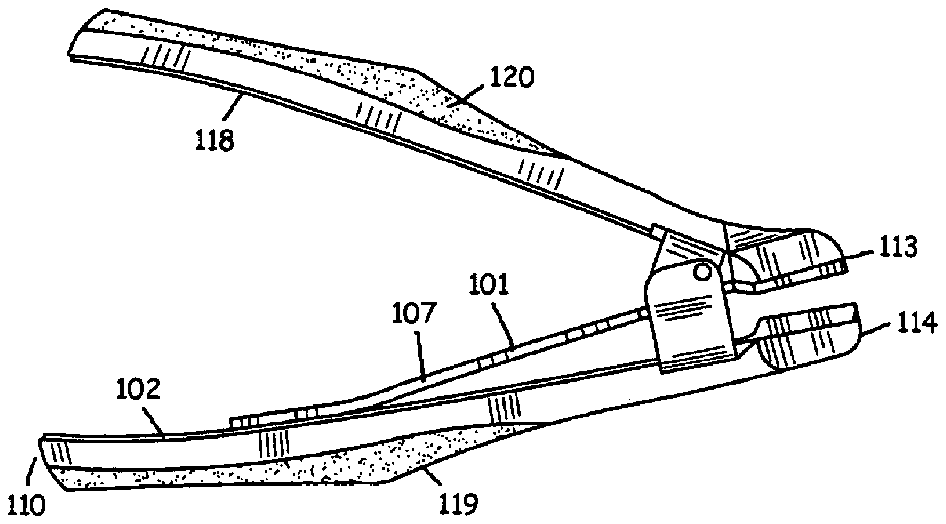
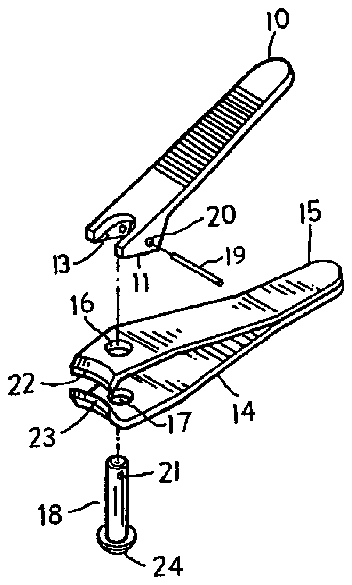
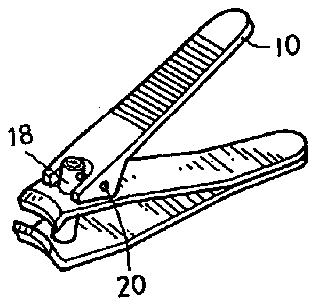
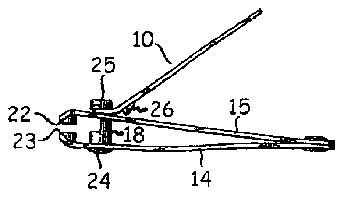
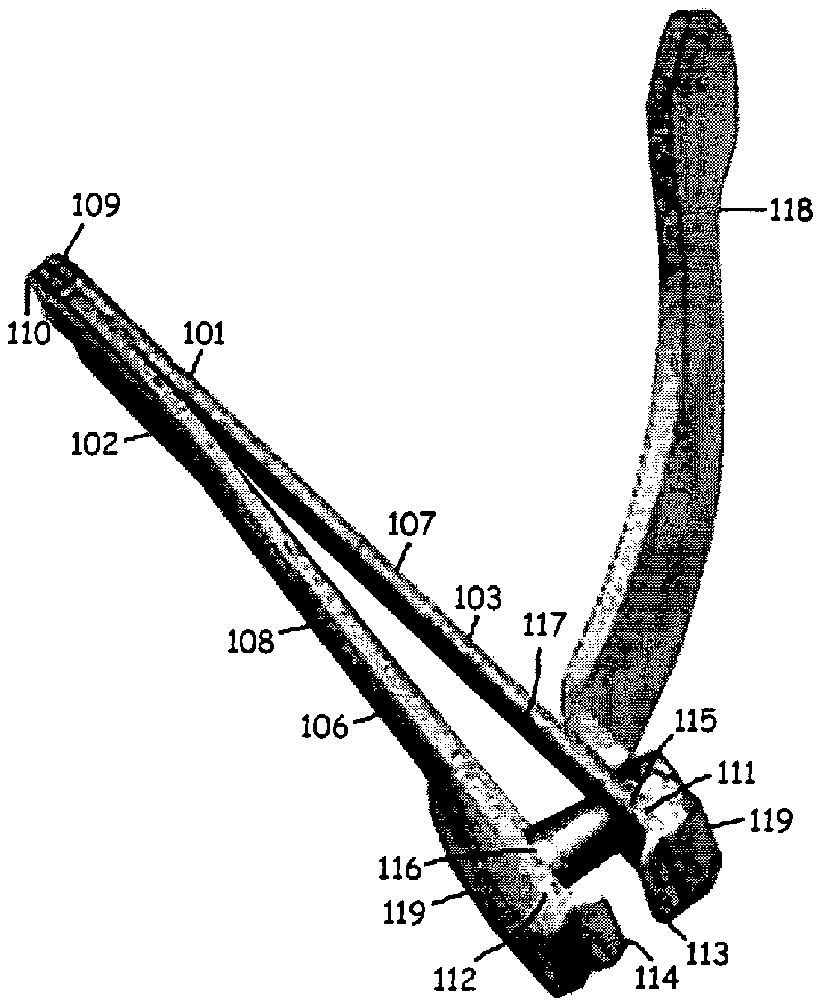
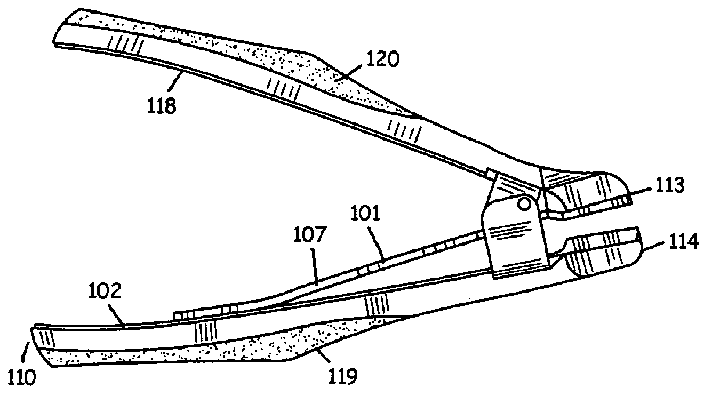
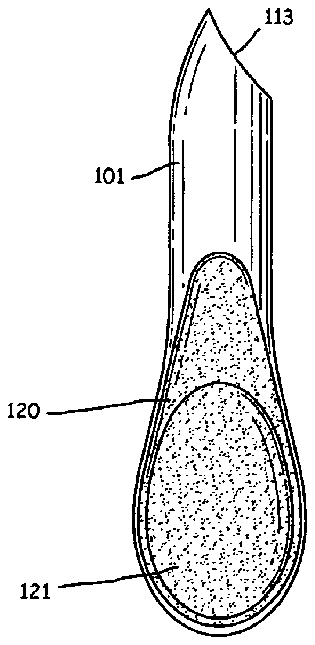
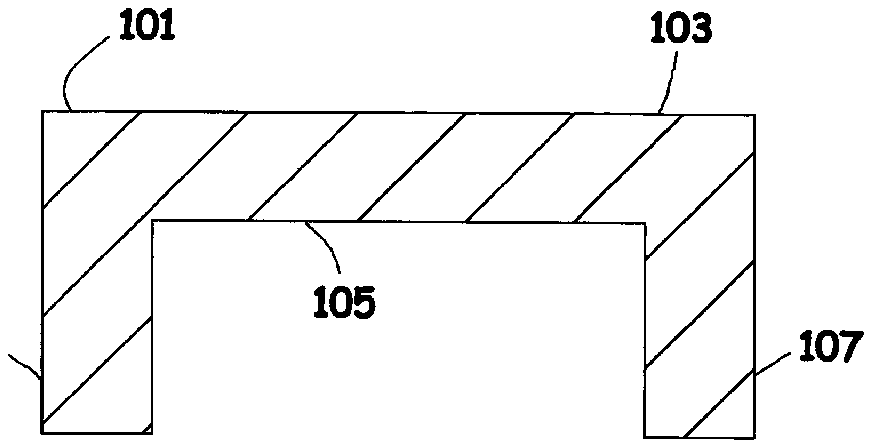
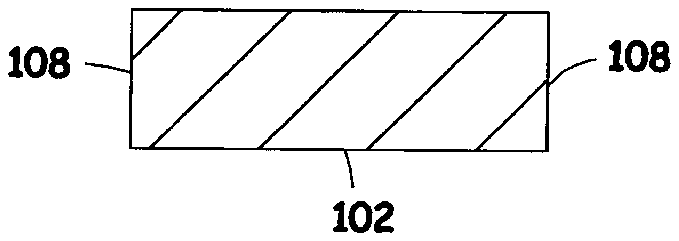
- 21 or
- 10lever
- 11triangle shaped section
- 13u-shaped opening
- 14lower body
- 15upper body
- 16holes
- 18pin
- 19pin
- 20pinhole
- 21pinhole
- 22cutting edges
- 24bottom end
- 25hook portion
- 26cam protrusion
- 101top member
- 102bottom member
- 103top surface
- 104top surface
- 105bottom surface
- 106bottom surface
- 107sides
- 109proximal ends
- 111distal end
- 112distal end
- 113cutting edges
- 114cutting edge
- 115openings
- 117post
- 118lever
- 119bumper
- 120triangular shaped member
- 121thumb accepting depression
Abstract
A nail clipper is provided in which the bottom has a projection bumper for positioning fingers of the user, and/or the cutting surfaces are colored as to be distinct from the nail to be clipped, and/or the upper surface of the clipper is configured so as to form saddle over the lower surface.
Description
BACKGROUND OF THE INVENTION
[0001] One type of a conventional nail clipper is shown in FIGS. 1 and 2 . A lever 10 having a triangle shaped section 11 at its front side and a U-shaped opening 13 at its front end is provided. The clipper includes a lower body 14 and an upper body 15 which are fixed together at their proximal ends and include holes 16 , 17 near their distal ends. A pin 18 is inserted through holes 16 , 17 in the bodies 14 , 15 and through the U-shaped opening 13 in lever 10 , and a second pin 19 is inserted through a pinhole 20 in lever 10 and a pinhole 21 in pin 18 so that the lever 10 can be combined with the upper body 15 . The tips of the distal ends of upper and lower bodies 14 , 15 , are provided with a pair of opposed curved cutting edges 22 , 23 for cutting a nail. The pin 18 has a large sized bottom end 24 which serves to engage the bottom surface of the lower body 14 so that the lower body 14 will not separate from pin 18 . In some instances, the bottom end 24 of pin 19 is soldered or screwed onto the bottom surface of lower body 14 .
[0002] The conventional nail clipper is assembled together as shown in FIG. 2 . Pressing down lever 10 to compress the upper body 15 causes cutting edges 22 , 23 to move so as to clip a nail placed between them.
[0003] An alternate conventional arrangement showed in FIG. 3 . In this construction, pin 18 is typically a rotatable, dowel-like rod having an enlarged head 24 at one end that seats on the underside of lower body 14 and a hook portion 25 at the other end thereof. An opening is provided in one end of the lever 10 so that pin 18 can fit through the opening and capture lever 10 by the hook portion. The lever has a cam protrusion 26 that contacts the upper side of the upper body 15 in a slideable relationship to form a fulcrum for transferring force from lever 10 to bodies 14 , 15 .
[0004] The present invention is designed to provide improvements in such conventional nail clippers.
SUMMARY OF THE INVENTION
[0005] The present invention provides an improved nail clipper which is more convenient to use than conventional nail clippers. In a first embodiment, the bottom surface of the bottom body is provided with a bumper terminating at a point intermediate the proximal and distal ends. The bumper provides for easier finger placement and increased stability when cutting, particularly with respect to individuals who made be elderly or infirmed. In the second embodiment, the cutting areas of the clipper are provided with a contrast color which makes it easier to visualize the nail area being cut. In a third embodiment, the upper member has a generally U-shape which envelops the bottom member and provides increased cutting leverage.
BRIEF DESCRIPTION OF THE DRAWINGS
[0006] FIG. 1 is an exploded perspective view of a conventional nail clipper;
[0007] FIG. 2 is a perspective view of the nail clipper of FIG. 1 ;
[0008] FIG. 3 is a side view of a second conventional nail clipper;
[0009] FIG. 4 is a perspective view of a first embodiment of a nail clipper according to the present invention;
[0010] FIG. 5 is a perspective view of a second embodiment of a nail clipper according to the present invention;
[0011] FIG. 6 is a top view of the second embodiment of a nail clipper of the present invention; and
[0012] FIG. 7 is a cross-section showing a modification of the top elongated member of the second embodiment and the relationship between the so modified top modified section and bottom elongated member.
DETAILED DESCRIPTION OF THE INVENTION
[0013] The nail clipper of the present invention, as shown in FIG. 4 , et seq., is composed of top and bottom elongated members, 101 , 102 , each of which has a respective top surface 103 , 104 and a bottom surface 105 , 106 interconnected by a pair of side surfaces 107 / 108 . Proximal ends 109 , 110 of the elongated members 101 , 102 are interconnected in any convenient fashion. The distal end 111 of the top member 101 is provided with a cutting edge 113 and the distal end 112 of the bottom member 102 is provided with an opposing cutting edge 114 . The cutting edges 113 , 114 are movable to enable a nail positioned between them to be cut. The cutting edges are preferably curved. They may be centered on the long axis of the top and bottom members 101 , 102 , as shown in FIG. 4 , or offset from that axis, if desired. The extent to which the cutting edges 113 , 114 project below or above the respective top and bottom members control the distance that those members may approach each other during the cutting operation.
[0014] Aligned openings 115 , 116 are provided in the top and bottom members 101 , 102 adjacent their distal ends. A post 117 extends through openings 115 , 116 and terminates above the top surface 103 of the top member 101 . The other end of post 117 can terminate in an enlarged head (not shown) which seats against the bottom surface 106 of bottom member 102 . The post 117 and enlarged head may either be fixed to the bottom member or be free standing. The nail clipper is provided with a lever 118 which is coupled to post 117 at the portion above the top surface of the top member 101 . Lever 118 can be coupled to post 117 so as to be pivotally engaged as shown in FIG. 1 or 2 or in FIG. 3 or in other arrangements, as desired.
[0015] In this embodiment of the invention, a bumper 119 is provided on the bottom surface 106 of the bottom member 102 . The bumper 119 can be a solid or hollow mass extending downwardly from the bottom surface 106 . It can be hard or pliable. An end of bumper 119 is positioned at a point that is part way between the proximal and distal ends bottom member 102 . In the embodiment shown in FIG. 4 , one edge of bumper 119 is positioned about ¼ or less of the distance between from the distal end toward the proximal end. The bumper 119 preferably extends to the cutting edge 114 and preferably, covers the enlarged head of post 117 . This arrangement helps to maintain post 117 in place should post 117 become uncoupled from lever 118 and also assists in preventing a finger from sliding toward the cutting edges. A second upwardly extending bumper 119 a is provided on top surface 105 of elongated member 101 in FIG. 4 extending from cutting edge 113 to pin 117 to reinforce the distal end of member 101 , but this can be eliminated if desired.
[0016] In a second embodiment shown in FIGS. 5 and 6 , bumper 119 extends from the distal end of lower member 102 and forms a triangular shaped grip. This bumper arrangement causes the fingers of the user to naturally lie on either side of the triangle's apex and away from the cutting edges 113 , 114 , thereby generally achieving the same biasing away from the cutting surfaces as in FIG. 4 . In this alternative, a triangular shaped member 120 with a thumb accepting depression 121 can provided on the lever 118 ( FIG. 5 ). The cutting surfaces in the FIG. 4-5 embodiment are displaced from the longitudinal axis of top and bottom elongated members 101 , 102 .
[0017] In a third embodiment, the distal ends 111 , 112 of top and bottom elongated members 101 , 102 , preferably including the cutting edges 113 , 114 , are provided with a color designed to contrast with the nail which is to be cut. See, FIG. 6 . The color may be, for instance, red, yellow or other colors. This arrangement assists in positioning the cutting edges 113 , 114 relative to the nail, especially in situations where the user has impaired eyesight.
[0018] The cutting edges 113 , 114 in the embodiment shown in FIG. 6 generally lie in the plane of top and bottom elongated members 101 , 102 . As a result, less force is applied to the cutting edges when lever 118 is depressed than realized in the embodiment shown in FIG. 4 . To address this situation, a modification of the third embodiment of the invention is shown in FIG. 7 . A portion of the thickness of top elongated member 101 facing bottom member 102 disposed adjacent distal end 111 distant from cutting edge 113 is reduced while the thickness adjacent the cutting edge as well as the extent of the sides 107 are maintained. Thus, the sides 107 of top member 101 in this arrangement not only connect the top surface 103 to the bottom surface 105 , they also extend beyond bottom surface 105 in that portion of top member 101 away from its distal end. In this portion, sides 107 and bottom surface 105 of top elongated member 101 combine to form a generally U-shape having an opening facing the top surface 104 of bottom elongated member 102 . The distance between sides 107 of top member 101 is greater than the distance between sides 108 of the bottom member 101 . The U-shape thus forms a saddle over the bottom elongated member 102 . When lever 118 is depressed, the bottom surface 105 of the proximal end of top member 101 is the first part of top member 101 to contact bottom member 102 and such contact tends acts to prevent further movement of top member 101 . The greater the rigidity of top member 101 , the greater the prevention of movement. The modification, however, causes the sides 107 of top member 101 at its proximal to extend beyond the respective side surface 108 of the bottom elongated member 102 when the top and bottom elongated members 101 , 102 are urged against one another, thereby permitting the top and bottom members 101 , 102 a greater extent of travel and applying more pressure urging cutting edges 113 , 114 into contact with one another.
[0019] Various changes and modifications can be made in the nail clipper of the present invention without departing from the spirit and scope thereof. For instance, the various embodiments disclosed can be combined as desired. Thus, the various embodiments described herein were intended to be illustrative only and were not intended to limit the invention.



